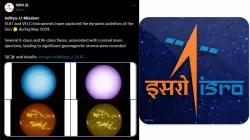Aditya-L1’s instruments capture solar activity, monitor major solar flares
On May 17, 2024, SUIT started taking pictures of Sun and provided important data to ISRO and other scientist around the world. The captured images are important for scientists to analyze the aftermath of the solar storms and the Sun's ongoing activity.

Aditya L1, an Indian solar observatory at Lagrangian point L1 which has been designed to “Observe and understand the chromospheric and coronal dynamics of the Sun” in a continuous manner has monitored major solar flares. During the week of May 8-15, 2024, the Sun's active region AR13664 unleashed a series of intense solar flares and coronal mass ejections (CMEs).
These events have accumulated a significant geomagnetic storm on May 11 (2024). Aditya-L1 played a crucial role in monitoring these solar activities as the spacecraft’s instruments- Solar Low Energy X-ray Spectrometer (SoLEXS) and the High Energy L1 Orbiting Satellite (HEL1OS), has reportedly captured the eruptions on May 8-9, 2024.
Also, the Advanced Solar Wind Plasma Experiment (ASPEX) and the Magnetometer (MAG) observed the geomagnetic storm on May 10-11, 2024, as the spacecraft passed through the L1 Lagrange point.
Key instruments in action: SUIT and VELC
Aditya-L1 is equipped with several highly designed instruments which are designed to observe and analyse solar phenomena. Two of these, the Solar Ultra Violet Imaging Telescope (SUIT) and the Visible Emission Line Coronagraph (VELC) are the most important instruments, which have been designed for studying the Sun's outer layers and corona.
However, during intense solar activity from May 10-11, 2024, these instruments were in calibration and protective modes and could not directly observe the events.
Operational challenges and resumption
Due to the critical nature of the solar eruptions, both- SUIT and VELC from Aditya-L1 were safeguarded to prevent any potential damage during the period of heightened solar activity.
Their protective doors were reopened on May 14, 2024, after the instruments had completed their calibration processes and the intense solar activity was abated. Following the reopening, these instruments further resumed their operational status, to capture further solar data for the Indian scientists.
Insights from SUIT post solar activity
On May 17, 2024, SUIT began capturing new images of the Sun and provided important data on the Sun's ultraviolet emissions, contributing to our understanding of solar dynamics and space weather impacts on Earth. The captured images are crucial for scientists to analyze the aftermath of the solar storms and the Sun's ongoing activity.
Collaborative efforts and broader observations
Other Indian space assets like the Chandrayaan-2 spacecraft and the X-ray Polarimeter Satellite (XPoSat), also contributed to observing these solar events. The ground facilities like the Udaipur Solar Observatory (USO) operated by the Physical Research Laboratory (PRL) further supplemented these space-based observations and the collaborative efforts have enhanced the comprehensive monitoring and understanding of solar activities, which has emphasized the significance of global cooperation in space weather research.
Continuing mission and prospects
Aditya-L1 is continuing to study the Sun and provide valuable data to scientists based in India as well as across the world. As it monitors solar activities and space weather phenomena, it further contributes to safeguarding the technological infrastructure of India and expanding our knowledge of the Sun.
The spacecraft’s instruments, especially SUIT and VELC are designed to to capture more critical data in the coming months, which will offer deeper insights into the behaviour of the Sun and its effects on the solar system.
ALSO READ: Elon Musk praises Indian-origin engineer, says 'Without him, we’d just be another car company
